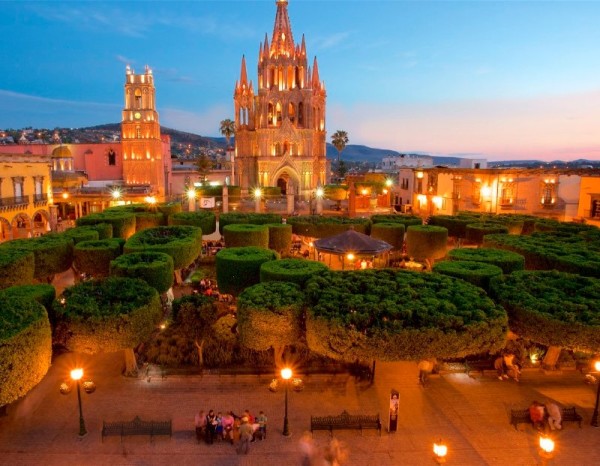Recently declared the American Capital of Culture 2019, San Miguel de Allende has been attracting American retirees since the late 1930s. A new report from the editors at Internationalliving.com explores why this nearby colonial city with its good-values, mild-climate, and rich arts culture is attracting such positive attention today.
“Media and cultural organizations have lavished San Miguel de Allende with praise of late – and with good reason,” says Jennifer Stevens, executive editor of International Living.
“At International Living, we’ve been writing about San Miguel for nearly 40 years now because it’s a great community for expats. These days, it’s one of the easiest places for a retirement abroad. Not only is the well-restored colonial city picture-perfect, it is a hive of activity with rich cultural offerings like theater, musical concerts, and art shows – all at a fraction of the price back home,” she added.
“A dynamic expat community includes lots of artists and writers. And the close proximity to the U.S. makes this a great city for folks who want a part-time home or simply the ease of a quick flight or drive back to the United States for regular visits. And to top it off, the climate is temperate year-round.”
Six thousand two hundred feet up in the mountains of central Mexico, San Miguel is a remarkable place to live in – it’s easy to see why expats are attracted to this city. The historic UNESCO World Heritage Site centro – which includes the famed pink stone, Gothic-style church La Parroquia – is simply stunning.
Recently, San Miguel earned the title of American Capital of Culture 2019, an honor bestowed by the International Bureau of Cultural Capitals, which is accredited by the Organization of American States.
“One of my favorite parts of living in centro is that I can walk to anything, whether it’s to the Ignacio Ramírez market for ingredients for dinner (I also love to pick up figs and apricots – a pound for around $2 USD), to meet with a friend for coffee, or enjoy an evening at a venue like Johnny’s Piano Bar,” says Jason Holland, IL Roving Latin America Editor, who lives with his family in San Miguel.

“It’s truly a pleasure to step out your door and be in the action. This is a thriving city, and there’s so much to see. There are restaurants for every cuisine. My favorite food is the street-cart al pastor (marinated pork) tacos for 50 cents each, just down the way from my house. Art galleries, restaurants, shops, artisan markets… if you live in centro, it’s all at your fingertips.”
Despite growing in popularity, San Miguel still offers a lower cost of living than north of the border – a couple can live well on $1,650 a month.
When Lindsey Adams Fenimore moved to San Miguel de Allende with her family last year, they were seeking a slower pace, a lower cost of living, and a chance for their children to learn Spanish.
“With its lively arts and music scene, world-class restaurants, and comfortable climate-the town attracted us from thousands of miles away,” she says, “From our living room in Milwaukee, Wisconsin, the pros and cons of making this move seemed plain to see. It was heavy on the pros.
“Rent ranging from $300 a month for a basic one-bedroom apartment to $1,500-plus for large, fancier homes. A gourmet meal with a glass of wine for $20. Fast internet connections. An abundance of art, music, and dance classes; yoga; recreational sports teams; cooking classes; horseback riding lessons; archaeological, cultural, and historic tours; and language schools.
“We’ve discovered, though, that the benefits of living in San Miguel de Allende extend way beyond that list. The pros are much more nuanced, more intangible, than what can be measured on a list.
“How do I measure the time I’ve reclaimed by not having to keep up with the hectic pace of U.S. life? How do I measure the excitement of waking up every day in a city that feels alive and letting my day unfold naturally? Some things can’t be measured.”
Perhaps most famously, San Miguel has a vibrant and innovative arts scene that you can take part in as a spectator or an active artist. In fact, that’s how San Miguel first became known to U.S. expats. Veterans from World War II discovered that the G.I. Bill could be used to attend art school in the city. It was a favorite haunt of the Beat Generation, too.
Margaret Nash moved to San Miguel de Allende 12 years ago, after meeting her Mexican husband, Luis, on an airplane. Having written a series of self-help books, she runs workshops and coaching. Margaret calls herself an “old hippie at heart,” and San Miguel is the perfect tonic.
“It’s much more low-key,” she says. “Small enough to know people, but big enough to be interesting. It’s colorful and full of energy, but not exhausting or draining. And the weather is nearly perfect all year. Because I’m semi-retired, I’m not dependent on my income to live, but I could do it if I had to because it’s so cheap to live here.”
Margaret says it’s very easy to set up a business from Mexico and to work from home. She and Luis live five minutes out of town and have a casita in their garden where she sees clients. “It feels like the countryside,” she says. “I’m outdoors most of the day and we rarely use air conditioning. Windows and doors stay open most of the time.”
Source: Internationalliving.com


